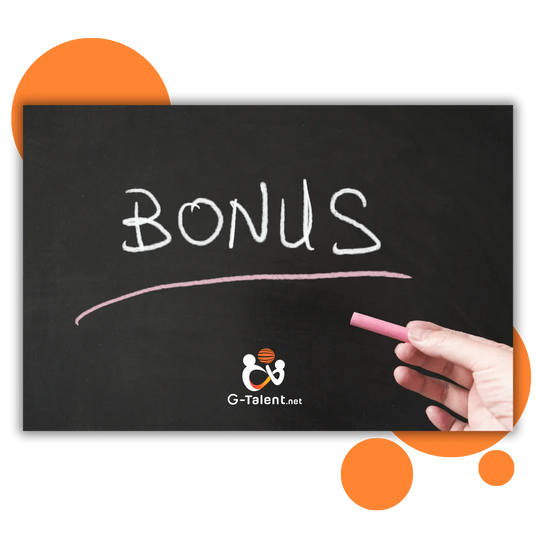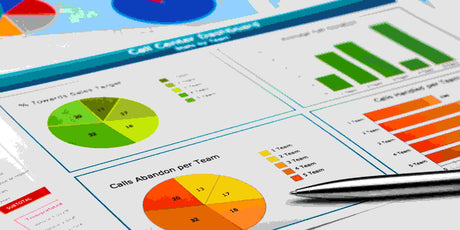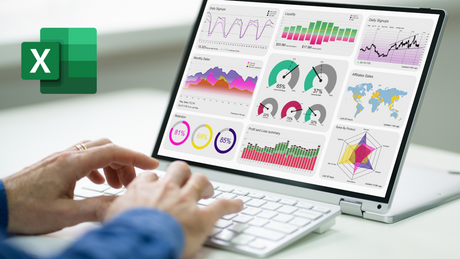Microsoft Excel basic to advanced and Power BI
By Miguel Angel Franco Garcia | Microsoft Office Specialist for Office 2019 and Office 365
15 day refund guarantee
This course includes:
▪️ 120 h 50m duration on demand
▪️ 595 lessons
▪️ 129 downloadable resources
▪️ Available on mobile devices
▪️ Access forever
▪️ Language:
- Spanish
▪️ Unlimited consultations
Supplementary materials
⚑ Certificate of completion
What you will learn
What you will learn
🟧 You will learn Excel from scratch, and end up becoming an expert data analyst.
🟧 You will learn tools such as conditional formatting in depth, and you will know how to use relative, absolute, and mixed references.
🟧 You will learn a lot of functions, all of them very important for everyday life.
🟧 You will see text functions, time functions, statistics, financial functions, lookup and reference functions, logical functions, and many more.
🟧 You will learn everything about pivot tables and target estimation functions.
🟧 You will learn about Power Query, Power Pivot, Power View, Power Map, and Power BI.
🟧 You will learn the 100 Excel productivity tricks.
🟧 You will create a professional dashboard from scratch, step by step.
🟧 You will apply new functions such as CONCAT, CLEAN, IFSET, SWITCH, CONCATENATE.
🟧 You will learn the new way of formulating with dynamic matrices, functions such as ORDERBY, SEQUENCE, FILTER.
🟧 You will learn with examples how to use functions in the normal way, and the same functions to generate dynamic matrices.
🟧 You will create dynamic graphs with spilled matrices.
🟧 You will learn how to create native Excel and custom charts and sparklines.
🟧 You will create your own calendars for your projects in Excel, or in a user form.
🟧 You will learn the latest in dynamic arrays, as well as array formulas and functions.
🟧 You will learn about the new LET, AND, LAMBDA functions.
Course content
Course content
U1: Basic Excel
- Introduction
- Cell, range, columns and rows, active cell, name box, formula bar
- Save, auto recover, and change language.
- Group defined names.
- Special glue.
- Insert a blank row every two rows.
- Select ranges, delete and add rows or columns, quick copy range.
- Undo, and, redo, delete, and, format copy.
- Working with sheets and windows.
- Keyboard shortcuts, and, autosum.
- Sort and filter group.
- Search and Select Group.
- Data tools group.
- Format cells.
- Shapes, and, images.
- Insert image into or over cell.
- Insert SVG file
- Data Entry, Autofill, Custom Lists.
- Comments.
- Links.
- Relative, absolute, mixed references.
- Conditional formatting.
- Tables.
- Merged cell in a table.
- Print views.
- Graphics.
- Forms.
- Edit links.
- How to determine the calculation mode.
- Copy data from the status bar.
- Percentage calculation.
- Navigation panel.
- Automatic data conversions.
- Show changes option.
- Check accessibility.
- Cell cleaning.
- Preview function value
- Improvements to copy and paste in Excel for the web.
- TRANSLATE and DETECTLANGUAGE.
U2: Intermediate Excel previous steps
- Functions and operators.
- Detailed analysis of a formula.
- Find syntax error.
U3: Artificial Intelligence
- ChatGPT
U4: Logical functions
- Conditional IF, Logical operators, IF.CONJUNTO.
- CHANGE function,
- The IFERROR function,
- IF.ND function,
- NOT function,
- The LET function,
U5: Statistical functions
- COUNT and COUNTA
- COUNTIF, and, COUNTIFS.SET
- MAX, and, MAXA
- MAX.IF.SET
- The AVERAGE and AVERAGEA functions
- The MODE.ONE, MODE.MANY, and MEDIAN functions
- The AVERAGE.LIMITED function
- COUNT.WHITE
- HIERARCHY.EQV
- K.ESIMO.MAYOR
- The TREND function
- PERCENTILE.INC/EXC, RANGE.PERCENTILE.INC/EXC
- QUARTILE.INC, and QUARTILE.EXC functions
U6: Mathematical and trigonometric functions
- SUMIF and SUMIF functions
- SUM, SUBTOTAL, and AGGREGATE functions
- Functions Integer, y, remainder
- The SUMPRODUCT function
- Calculate budget with actual sales
- ROUND, ROUND.EVEN, ROUND.ODD functions
- ROUNDUP and ROUNDDOWN functions
U7: Text and reference functions
- LEFT, RIGHT, UPPER, LOWER, PROPER.
- The LEN function.
- FIND and FINDING
- The EXTRACT function
- The REPLACE function
- The REPLACE function
- Correct errors between two strings
- The CONCATENATE, CONCAT, and CONCATENATE functions
- The SPACES function
- The REPEAT function
- The TEXT function
- EQUAL function
- CODE and CHARACTER functions
- T function
U8: Date and time functions
- Difference between 1900 and 1904 dating system
- The functions TODAY, NOW, YEAR.MONTH, DAY
- DATE.MONTH, and, END.MONTH
- The DATEIF function
- The DAYS function
- The WEEKDAY function
- The DATE function
- The YEARFRAC function
- The DAY.LAB, DAYS.LAB, and DAYS.INTL functions
- The WORKDAY.INTL function
- The ISO.WEEKNUMBER, TIMENUMBER, and VALUE functions
- WEEKNUM Function
- Calculate the difference between hours
U9: Intermediate Excel. Search functions.
- MATCH, and, MATCHX functions
- LOOKUP, VLOOKUP, and HLOOKUP functions
- The XLOOKUP function
- Resolving VALUE error in XLOOKUP function
- The INDEX function
- Sort duplicate values
- The INDIRECT, and, ADDRESS functions
- The OFFSET function
- The HYPERLINK function
- Create a sheet index with HYPERLINK
- The CHOOSE function
- Formula audit
U10: Information functions
- ES Functions
- Function N
- NOD Function
- SHEET function
- SHEETS function
U11: WEB Functions
- IMAGE function
U12: Python in Excel
- Python in Excel
U13: Intermediate Excel. Collaboration tools
- Book protection
- Change control
- What happened to shared books?
- Co-authorship
U14: Cell controls and correspondence
- Checkbox.
- Correspondence in Word with Excel.
U15: Intermediate Excel. Pivot tables
- Part 1
- Part 2
- Part 3
- Part 4. Filters
- Part 5. Group or ungroup dates
- Part 6. Grouping fields
- Recommended pivot tables
- Part 7. Data segmentation and time scale
- Sort row labels, and, column labels
- Part 8. Calculating values
- Part 9. Calculated field
- Part 10. Calculated element
- Part 11. OLAP tools, and IMPORTING DYNAMIC DATA
- Part 12. Linking pivot tables
- Part 13. Consolidating data
- Part 14. Obtaining data from external data
- Part 15. Pivot table from dataset
- Part 16. Example. Displaying report filter pages, and, difference between months
- Example: Show achieved or not achieved
- Sort data segmentation
- Analyze data
- Summarize by week and center
- Show details
U16: Intermediate module examples
- Determine if a year is a leap year.
U17: Functions, Forecasts, Solver, Data Analysis
- BDSuma
- BDExtract / BDMAX / BDMIN
- Forecasts
- Hypothesis analysis
- Solver
U18: Data types
- Quotes and geographic information
- Data Types. Currency
- FIELDVALUE Function
- Create data type in Power Query
- QUOTEHISTORY Function
- Data Types and Images in PivotTables
U19: Advanced module. Financial functions
- The functions PAYMENT, PAYINT, and PAYPRINC
- The PAGOPRINCENTRE and PAGOINTENTRE functions
- The LINEAR AMORTIZATION and PROGRESSIVE AMORTIZATION functions
- The DB, Y, SYD functions
- The COUPON.DAYS function
- The VA, VF, NPER, and RATE functions
- Calculating the depreciation of an asset using DB
- INT_ACUM Function
- The PERCENTILE RANK function
- NPV Function
U20: Office 365 Scripts
- Office 365 Scripts.
- Automate script with Power Automate.
U21: Automate tasks with Power Automate
- Copy folder and add the word Spain_.
U22: Array Functions and Formulas
- Array formulas
- Dynamic Array Formulas vs. Legacy CSE Array Formulas
- Matrix spilled or overflowed
- Precautions, and, limitations
- Overflow error
- Implicit operator @
- Spilled range operator (#)
- Use of the dollar symbol
- The matrix function SORT
- The matrix function ORDERBY
- The UNIQUE function
- The TRANSPOSE function to reverse rows by columns
- The SEQUENCE matrix function
- The FILTER matrix function
- Report tied matches (FILTER)
- The FREQUENCY function
- The matrix function MATRIZALEAT
- The MMULT function
- The TEXTBEFORE, TEXTAFTER, SPLITTEXT functions
- VSTACK and HSTACK functions (VSTACK/HSTACK)
- Repeated consecutive birds (hstack)
- The TOCOL (ENCOL) and TOROW (ENROW) functions
- Countries that improved and those that worsened (ENCOL)
- Fruit counting (ENCOL)
- The WRAPCOLS and WRAPROWS functions
- The TAKE and DROP functions
- The CHOOSEROWS and CHOOSECOLS functions
- Fruits between dates
- The EXPAND function
- WRAPROWS function error
U23: Tasks
- Filter by more than one criterion.
- Replace the last letter "a".
- Fill empty cells with earlier or later dates.
- Fill out invoice with 23s and zeros.
- Split sales from table1 to table2.
U24: LAMBDA Functions
- LAMBDA function
- BYCOL function
- BYROW function
- Examples1. BYROW
- Examples2. BYROW
- Left and right chain operations (BYROW)
- MAP Function
- Examples1 (MAP)
- Examples2 (MAP)
- The REDUCE function
- Examples1 (REDUCE)
- Examples2 (REDUCE)
- Extract special characters (REDUCE)
- The SCAN function
- The MAKEARRAY function
- The ISOMITTED function
- GROUPBY, PIVOTBY, PERCENTAGE
U25: Convert numbers to text
- Convert first character from the right to text
- Convert to text first, and, second character from the right
- Correct errors and test in another book
- Convert third character to text
- Convert the fourth character to text
- Convert the fifth character to text
- Convert the sixth character to text
- Convert the seventh character to text
- Union of all digits
U26: Regular expressions
- REGEXTEST, REGEXEXTRACT, REGEXREPLACE.
U27: Power Query
- Introduction
- Power Query. Part 1
- Option type changed
- Create route dynamically
- Power Query. Part 2
- Power Query. Part 3
- Power Query. Part 4
- Nested IF Example
- Power Query. Part 5
- Power Query. Part 6
- Power Query. Part 7
- Power Query Zone. Generate holidays
- Power Query Zone. Splitting compound names
- Calculation of time difference
- Types of data
- Create tabular model from model with multiple headers
- Upload multiple PDF files from a folder to Excel
- Getting data from an image
- Join multiple tables with Excel.CurrentWorkbook()
- Excel.CurrentWorkbook example continued
- Excel.CurrentWorkbook to choose which tables to load
- Group by to calculate the standard deviation
- Recursive Functions
- M. Language Part 1
- M. Language Part 2
- How to create lists
- #table
- Text Functions
- Time functions
- #date, Date.AddYears, dateTime.LocalNow, Date.From, Duration.Days
- GroupKind.Type
- Text.Upper Function
- Text.Repeat Function
- List.Generate
- List.Select and Each
- List_Dates and Date_Day. Report with dates with and without sales
- ListZip and TextSplit
- List.InsertRange, and, List.Count
- List.TransformMany to create multiplication table
- Change regional settings
- Record.Field Function
- Filter by three criteria with Table.SelectRows
- TableInsertRows, TableRowCount, add blank row between provinces
- Table.FromRecords and Table.AddColumn
- Table.SelectRows, and, List.Contains
- Table.FromColumns put multiplication tables into columns
- Table.RemoveMatchingRows, Table.FromRecords, Table.ToRecords
- Table.Profile. Remove empty columns
- Table.Skip Function
- Table.AddIndexColumn and Table.FromValue
- Table.SplitColumn and Splitter.SplitTextByDelimiter
- Table.SplitColumn, and, Splitter.SplitTextByCharacterTransition
- Table.TransformRows, and, Table.Transformcolumns
- Table.UnpivotOtherColumns, unpivot columns
- Unpivot other columns with null values
- Poorly structured model
- Normalize model
- Create cumulative
- Append tables with different headers
- Find center for each product
- Make a column with the subtraction of the previous cell
- Provinces and centers with a quantity less than or equal to 5
- Search by the initials of a province
- Total by cross date with center
- Convert row model to columns
- Exact match search
- Combine books with different sheet names
- Calculate discount per unit
- Accumulated per day, and, month
- Insert 3 rows in each row of the model
- Filter by province
- Sort by our criteria
- Remove top rows dynamically
- Remove columns starting with Num dynamically
- Append queries using a function
- Calculation of total by employee and group
- Calculation of the total per shopping center
- Filter by three criteria
- Report by centers and equal products
- Attach queries with M
- Create index with duplicates
- Maximum date by province
- Monthly sales by date and province
- Single list case sensitive
- Average minus total across a parameter
- Recover record with province and maximum date
- Products by province
- Dynamically split a column
- Create dynamic index
- Calculate the difference between hours and minutes
U28: Power Pivot for excel 2016 (valid for excel 2019)
- What is Power Pivot.
- Start the Power Pivot add-in.
U29: Main icons in Power Pivot
- Adding tables to the data model
- Power Pivot Menu Icons
- Get started managing your data model in Excel 2016
- Main menus of the data model
- Creating relationships between tables in Power Pivot
- Pivot table from Power Pivot model
U30: Importing data into Power Pivot
- Data sources to build the model
- Getting data from an Access database
- Get data from a .CSV or .TXT file
- Getting data from Excel
- Obtaining data from other sources
U31: Pivot Tables and Charts in Power Pivot for Excel 2026
- Pivot tables and charts
- Advanced Actions in PivotTables
- Possibilities to create multiple dynamic charts
- Segmenting dynamic tables and charts
- Dashboard or control panel with Power Pivot
U32: Processing data in Power Pivot in Excel 2016
- Format model data.
- Different options with existing filters.
- Perform actions on columns.
- Hide tables and columns.
U33: Calculations and formulas in DAX
- AutoSum and Count
- Statistical operations with autosum
- Introduction to DAX formulas
- Calculated or Measured Columns
- Excel Legacy Functions
- Functions used in Excel
- Intermediate formulas in DAX for Excel 2016
- Other DAX functions in Excel 2016
U34: Calculating KPIs in Power Pivot for Excel 2016
- What are KPIs?
- A look at the KPI tool.
- Create KPIs.
U35: Sharing and saving your models
- Save data models in different locations.
- Share your data models with collaborators.
- Protect Excel workbook with data model.
U36: A look at Power View
- Introduction and installation.
- Key actions in Power View.
- Create your first dashboard in Power View.
U37: Power Map
- Power Map
U38: CALCULATE Function
- CALCULATE function.
- CALCULATE and CROSSFILTER.
- CALCULATE, FILTER, ALL, KEEPFILTERS.
U39: Examples
- Example: Create a dynamic slicer
- Report showing dates with and without sales
- Calculate amount and shipping per product
- Calculation of budgeted minus actual sales
- Calculation of sales and advertising costs
- Calculation of total by product and seller
- Accumulated in power Pivot
- Calculation of total by product
- Discount calculation based on quantity
- Ranking of totals
- Calculation of totals without weekends
- Totals by centers and products
- Calculation of discount by units sold
- Total by department and employee
- Maximum minus minimum calculation error
- Total count by date
- Average not counting zero values
- Calculation of the grand total
- Calculation of units and total per product
U40: Macros. Previous steps, environment and first macro
- Introduction
- How to save a file with macros
- Macro recorder
- Our first macro
- Ways to protect a book
- Application Object
- Collections and objects
- Cells and range
- Other properties of Range
- Working with sheets in VBA
- Arrays in VBA
- Example of matrices
- Other FOR loop parameters
- The FOR...EACH loop
- The IF...THEN statement
- Variables
- Thisworkbook
- The INPUTBOX function
- The SELECT CASE statement
U41: Macros. Advanced filter, and reports with advanced filters
- What is an advanced filter?
- Filter Report via a macro with advanced filter.
- Another way to filter with advanced filter.
- Advanced filter with graphics.
U42: Forms
- What is a form?
- Forms. Part 2
- Forms. Part 3
- Listbox
- Forms. Part 4
- ComboBox Control
- Alignment, togglebutton, wordwrap and multiline
- CanUndo, CanRedo, UndoAction, RedoAction
- Accelerator and caption. Assign shortcut to a control
- Picture, loadpicture, left, top, height, width
- The controls collection
- Cut and paste methods
- Dbclick event, CanPaste property, and Paste and Copy methods
- DragBehavior, and EnterFieldBehavior properties
- ShowDropButtonWhen property, and DropDown method
- GetFormat, GetText, SelText, and TextLength
- KeyPress, and, Move events
U43: Economic-financial dashboard (scorecard)
- Introduction
- Definition and context
- KPI concept. Key Performance Indicator
- The map or composition of a dashboard
- Strategy when creating a dashboard. Audience and message
- KPIs and tables needed when creating a dashboard
- Strategy when creating a dashboard. Data source
U44: Dashboard. The most important parts of a dashboard
- The options or configuration sheet
- The auxiliary sheet of a dashboard
- The Data stage. The beginning
- The Analysis stage. The data, once processed
- The Visualization stage to present the information
U45: Dashboard. Building the dashboard_Previous steps
- A walk through our future dashboard, now finished
- Audience and message to convey with the dashboard
- Determining KPIs and chart types.
- Sketch of our dashboard.
- Tables and data required in the dashboard.
- Origin and method of obtaining the data.
- Tips for configuring dashboard sheets.
- The Cover, Auxiliary and Configuration sheets.
- Special controls for the dashboard.
U46: Dashboard. Building the dashboard_Stage 1. Data
- Import data by merging tables. Option 1.
- Import data by relating tables. Option 2.
- Import data with connection to Access. Option 3.
- Import data via clipboard. Option 4.
- Import data with connection to Excel. Option 5.
- Problems with data connections.
- Update connected data.
- Add other necessary columns.
U47: Dashboard. Build the dashboard_Stage 2. Analysis.
- Assumptions before starting to build the dashboard.
- Creating the first pivot tables.
- Replicating pivot tables.
- Filtering pivot tables.
- The averages table. AVERAGE and IFERROR functions.
- The IF function in the table of averages.
- The pre-dashboard sheet. Month titles.
- Other figures needed on the dashboard.
- Speedometer figures on the dashboard.
U48: Dashboard. Building the dashboard_Stage 3. Visualization
- Basic dashboard display areas.
- Create text boxes for numeric KPIs.
- Create the dashboard combo chart.
- Speedometer graphics.
- Create the speedometer charts on the dashboard.
- Create the ring charts.
- Create the income statement.
- Create data segmentation.
- Format the slicer panel.
U49: Dashboard. Building the dashboard. Automation and protection
- Automate dashboard zoom.
- Protecting our dashboard.
U50: Another Alternative Dashboard
- Preview of our new dashboard.
- The Data sheet. The source table of the dashboard.
- Sales table by route and agent.
- Create pivot table for Sales by Agent section.
- Create the ring chart in the dashboard.
- Bar chart for ranking of best clients.
- Special bar chart for best selling products.
- Create a calculated field for sales commissions.
- A splash of color with conditional formatting.
- Create grouping of dates by months and years.
- Data segmentation to filter everything in a coordinated manner.
U51: Excel Tricks
- Introduction.
- 3 tricks to speed up Excel performance.
- 5 tricks from Excel's 'Options'.
- Remove gridlines from a sheet.
- Minimize the size of an Excel file.
- 2 tricks to highlight cells automatically.
- Restore Excel default settings.
- Delete everything in a cell or range of cells.
- Change negative sign from right to left.
- Force phone number format.
- 5 Tricks to improve our graphics.
- Prevent an area chart from plotting zeros.
- How to make an interactive graph.
- Charts within a cell with Repeat.
- 3 tricks for cell editing.
- Drop-down lists in Excel.
- 5 tricks for entering data quickly.
- Comments inside formulas with the N function.
- Insert icons and symbols in Excel.
- Insert an equation in Excel.
- Fix an error made in multiple formulas.
- Leave unique values in a list.
- Filter a table field by more than two criteria.
- Sort a table by more than one field
- Tricks for aligning graphics and shapes.
- Opening Excel workbooks.
- Quick Launch Bar in Excel.
- Tips for selecting ranges quickly.
- 3 Quick Cell Hacks That Save Time
- Debug tables imported from an ERP with a macro.
- Transpose rows to columns or vice versa.
- 5 tricks to protect our information.
- Share a workbook and review changes.
- Detect differences and duplicates in lists.
- Allow VBA to run macros on protected sheets.
- Using CodeName in VBA to avoid inconsistencies.
- Two ways to do cumulative sums.
- See a preview of what will be printed.
- Sum ranges with hidden or error rows.
- Move around Excel more quickly.
- Various tricks for handling text.
- Adjusting columns and rows in Excel.
- Print Excel professionally.
- Filter a table by color.
- Cool tricks to impress the boss.
- Create a new Excel workbook from a sheet.
- Merge cells horizontally.
- Lock objects on row deletion.
- Pivot table with multiple source tables.
- Calculate the quarter corresponding to a date.
U52: Excel Charts
- Introduction.
- Comparison between different data in a graph.
- Evolution and trend.
- Compare what has been achieved with a goal.
- When the important thing is to see the parts of a whole.
- Cause and effect using graphs.
- How to show how fast an increase or decrease occurs.
- Abundance or scarcity in a sample
- Pareto chart
- Charts with multiple categories
- Surface graphics.
- Choropleth charts and sparklines
- The outer area and plot area of a graph.
- Horizontal, vertical and secondary axes of an Excel chart.
- Title, legend, and axis titles of a graph.
- The dividing lines.
- Data labels.
- Series and categories.
- Trend lines.
- Other elements.
- Colors, formats and sizes.
- Pie charts.
- Labels, legends and titles in charts
- Multi-series charts.
- 3D and textures not recommended.
- Clarity in a chart.
- Avoid visible zeros in line graphs.
- Charts with Excel tables.
- A graph in Power Point.
- Simple tricks to learn for an Excel chart.
- Images in column charts.
- Maximums and minimums in a graph.
- Separate slices of pie charts.
- Vertical scale with negative numbers.
- Line graph with multi-colored sections.
- Compare data to the average.
- Increment and decrement symbols.
- Interact with the chart using drop-down lists.
- Compare data in a chart with a margin strip.
- Add dynamic legend to a stacked column chart.
- Horizontal axis two different data.
- When the scale does not start from zero.
- Ring chart.
- People plugin.
- Custom sparklines.
- Line graphs.
- Charts with data segmentation.
- Charts with time scales.
- Gantt charts.
- The Forecast tool.
- Bar graphs with human figure icons.
- Map graphics.
- Speedometer graphic.
- Thermometer Charts. Part 1.
- Thermometer graphs. Part 2.
- Conditional formatting with formulas to highlight alternate rows.
- Conditional formatting for charts.
- PivotChart from a PivotTable.
- Limitations and peculiarities of dynamic graphics.
- Histogram
- How to create a pie sparkline.
Course evaluation
- This course contains a final exam
G-Tools: For Students
- Exclusive access to cutting-edge student tools: improve your employability, participate in exclusive events, take advantage of our intelligent virtual assistant, and more.
⚑ Certificate of completion
- Your personalized digital certificate, a unique badge of your achievements, with international validity, course duration and QR code for instant verification.
__
Downloadable resources:
📎 Downloadable Guide Set:
▸ More than 120 sets of materials for practice
Description
Description
✔️ This course will start with the basic module, where we will learn the basic concepts, such as what a row, a column, a cell and a range are. We will create a linked image from a data model.
We will learn the main and perhaps the most useful keyboard shortcuts, such as CTRL and =, which is the auto-sum shortcut.
We will use the format copyer tool on the home tab, both to copy to adjacent cells, as well as cells that are not contiguous.
We will see how to view, for example, two Excel sheets on the same screen through the view tab.
We will freeze panels. We will also learn how to use relative, absolute and mixed references perfectly with practical examples.
We will see how to use the autosum command, custom formatting, flash fill, and everything about conditional formatting, and conditional formatting with formulas, for example, to tell us what the largest amount is within a data model.
We will learn how to make our first graphs, and what their parts are, such as the use of the secondary axis.
We will also set up a sheet to be printed, for example, making the title print on all sheets, how to put a header and a footer and adjust the sheet, we will also see the page breaks.
Of course, we will see what a table is, and what difference it has with respect to a range. We will sort by more than one criterion, we will see the search and replace command.
We will see in this basic module what the weighted average is, and how it is calculated manually with the SUMPRODUCT function.
Companies from all industries invest in the development of their teams with this course from G-Talent and Miguel Angel Franco Garcia


Miguel Angel Franco Garcia
Microsoft Office Specialist for Office 2019 and Office 365
About Miguel Angel Franco Garcia
About Miguel Angel Franco Garcia
Microsoft Office Specialist for Office 2019 and Office 365
Expert in data analysis, Power BI, DAX and Power Pivot, with more than 15 years of experience in teaching these tools to students, professionals and companies. Miguel Ángel has perfected a teaching method that allows his students to learn quickly and efficiently, combining tutorials, videos and practical exercises.
With a solid career as an instructor, Miguel has helped hundreds of people master the essential skills for handling big data. His teaching approach is geared towards helping his students to be able to handle high-quality pivot tables, interactive charts and dashboards with ease. He also teaches how to create databases, perform advanced searches and establish relationships between tables, all with the goal of generating accurate and visually striking reports.
Miguel Ángel not only teaches the technical functionalities of Excel and Power BI, but also focuses on how to apply these tools in real-world contexts, making them invaluable for decision-making in any work environment.
What makes Michelangelo different?
▪️ Experience in Data Analysis: With more than 15 years of experience, Miguel Ángel has taught people of all levels to manage and analyze data efficiently.
▪️ Efficient Teaching Method: Its approach combines tutorials, videos and practical exercises, which facilitates fast and effective learning.
▪️ Practical Application: Miguel Ángel specializes in teaching his students to apply what they have learned in real work situations, maximizing the impact of their knowledge.
If you want to master Microsoft Excel, Power BI, and data analysis tools quickly and efficiently, Miguel Ángel Franco García is the ideal instructor for you.

Discover the added value: G-Tools and much more
In addition to high-quality content, this course gives you access to G-Tools, a suite of tools and resources designed to enhance your learning and your career.
Employability support resources, live events and take advantage of Aixa.IA's artificial intelligence to resolve your questions at any time.
Microsoft Excel básico hasta avanzado y Power BI
Me encantó el curso dado que va de lo más básico desde la configuración de la barra de herramientas hasta fórmulas mucho más complejas. Además tiene muchos ejercicios
Es un buen curso, explicativo y lo mejor de todo es que puedo hacerlo a mi ritmo. Lo que faltaría quizá sería más ejercicios de las primeras lecciones. Todo lo disponible es para las lecciones avanzadas.
Esta formación ha sido una de las más completas que he tomado, en mi día a día me ha ayudado de pasar a ser un usuario básico y uno bastante experto, su plataforma muy amigable, tuve algunos inconvenientes al registrarme pero su area de soporte me soluciono en poco tiempo. Gracias!
Son varios los cursos que he hecho con ustedes, sin embargo, este curso ha sido el más completo y valioso que he realizado. Me ha convertido en un verdadero experto en Excel y ayudado mucho con Power BI. Lo recomiendo al 100%, gracias!
Explore other courses from Miguel Angel Franco Garcia
Discover other courses and learn something new today. Learn from the best!
Best Selling Courses in Personal Development
-
Handling Difficult People at Work: Effective Strategies to Improve Your Work Environment
★★★★★(18)$15.99 USD$59.99Unit price /Unavailable -
-
-
-
-
Analytics and Artificial Intelligence with Power BI
★★★★★(10)$15.99 USD$75.00Unit price /Unavailable -
ChatGPT for Professional Tasks and Microsoft Office
★★★★★(13)$15.99 USD$67.00Unit price /Unavailable -
-
-
B2B Consultative Sales: Innovation and techniques for extraordinary results
★★★★★(9)$15.99 USD$97.00Unit price /Unavailable -
-
-
-
-
-
-
-
Training of Internal Auditors in Quality Management Systems
★★★★★(179)$15.99 USD$74.99Unit price /Unavailable
What to expect from G-Talent courses?
-
Study at your own pace
Get video courses, taught by top instructors, to study at your own pace
-
Learn from the best
Provides high quality courses developed by carefully selected experts
-
Quality guaranteed
Not sure? All our courses offer a 15-day success guarantee
-
Permanent accompaniment
Learn at your own pace, with lifelong updates, access and support.
-
Personalized certificate
Get a world-class certificate, with international validity and a unique encrypted QR code
-
G-Tools: For Students
Find all the tools you need for your employability in one place.
























